HistoryUsually said to be founded by Eumenes II, king of Pergamum (197-159 BC), Hierapolis may actually have been established closer to the 4th century BC by the Seleucid kings. The name of the city may derive from Hiera, the wife of Telephus (son of Hercules and grandson of Zeus), the mythical founder of Pergamum. Or it may have been called the "sacred city" because of the temples located at the site. (The name Pamukkale is sometimes used just to refer to the white terraces, but the modern name of the whole area is also Pamukkale.) With Colossae and Laodicea, Hierapolis became part of the tri-city area of the Lycus River valley. Hierapolis was located across the river from the other two cities and was noted for its textiles, especially wool. The city was also famous for its purple dye, made from the juice of the madder root. The hot springs at Hierapolis (which still attract visitors today) were believed to have healing properties, and people came to the city to bathe in the rich mineral waters in order to cure various ailments. Hierapolis was ceded to Rome in 133 BC along with the rest of the Pergamene kingdom, and became part of the Roman province of Asia. The city was destroyed by an earthquake in 60 AD but rebuilt, and it reached its peak in the 2nd and 3rd centuries AD. The city fell into decline in the 6th century, and the site became partially submerged under water and deposits of travertine. It was finally abandoned in 1334 after an earthquake. Excavations began to uncover Hierapolis in the 19th century. |
Biblical SignificanceHierapolis is mentioned only once in the Bible, when St. Paul praises Epaphras, a Christian from Colossae, in his letter to the Colossians. Paul writes that Epaphras "has worked hard for you and for those in Laodicea and in Hierapolis" (Colossians 4:12-13). Epaphras was probably the founder of the Christian community at Hierapolis. Hierapolis had a significant Jewish population in ancient times, as evidence by numerous inscriptions on tombs and elsewhere in the city. Some of the Jews are named as members of the various craft guilds of the city. This was probably the basis for the Christian conversion of some residents of Hierapolis, recorded in Colossians 4:13. In the 5th century, several churches as well as a large martyrium dedicated to St. Philip were built in Hierapolis. Ancient tradition associates Hierapolis with a biblical figure, reporting that Philip died in Hierapolis around 80 AD. However, it is not clear which Philip is meant. It could be Philip the Apostle, one of the original 12 disciples, who is said to have been martyred by upside-down crucifixion (Acts of Philip) or by being hung upside down by his ankles from a tree. Or Philip could be Philip the Evangelist, a later disciple who helped with administrative matters and had four virgin-prophetess daughters (Acts 6:1-7; 21:8-9). Early traditions say this Philip was buried in Hierapolis along with his virgin daughters, but confusingly call him "Philip the Apostle!" In any case, it seems a prominent person mentioned in Acts did die in Hierapolis.
|
 Our first view of the white calcified cliffs of Hierapolis, the result of calcium deposits from the mineral-rich water that still flows over the cliffs.
Our first view of the white calcified cliffs of Hierapolis, the result of calcium deposits from the mineral-rich water that still flows over the cliffs.
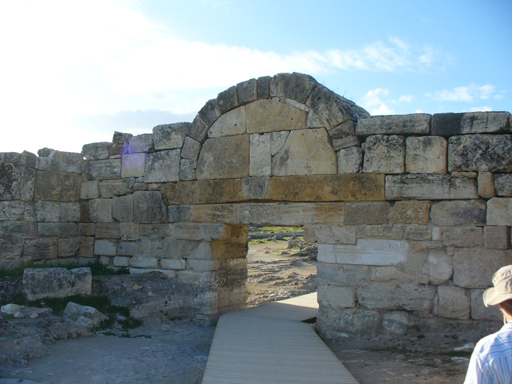 The South Byzantine Gate into Hierapolis.
The South Byzantine Gate into Hierapolis.
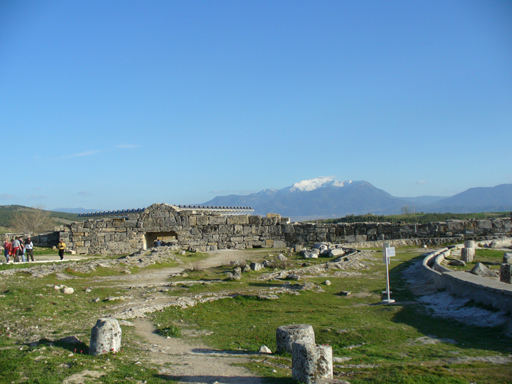 Looking back at the gate.
Looking back at the gate.
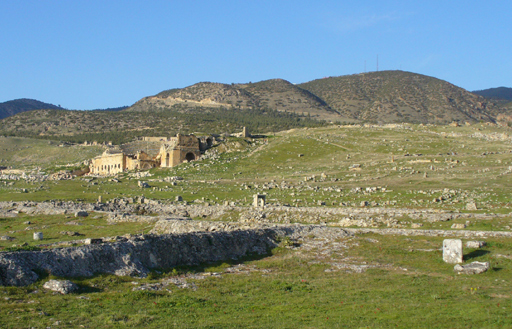 The larger building is the nymphaneum, a monumental 4th century fountain. Behind it are the remains of the Temple of Apollo.
The larger building is the nymphaneum, a monumental 4th century fountain. Behind it are the remains of the Temple of Apollo.
 Looking beyond these two buildings, under the trees is the Martyrion of St. Philip, constructed in the 5th century, supposedly on the site where he was martyred.
Looking beyond these two buildings, under the trees is the Martyrion of St. Philip, constructed in the 5th century, supposedly on the site where he was martyred.
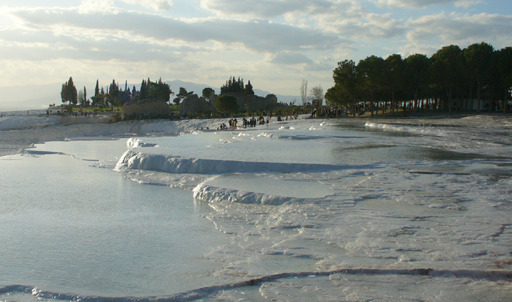 The pools.
The pools.

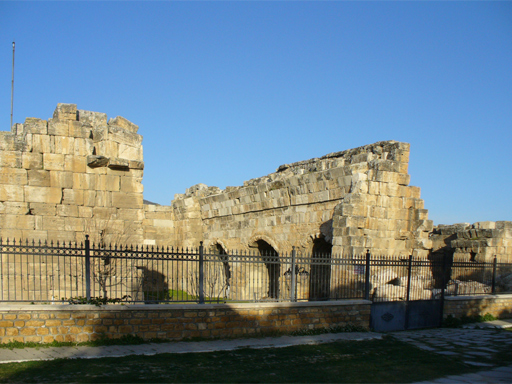 The Roman Bath.
The Roman Bath.
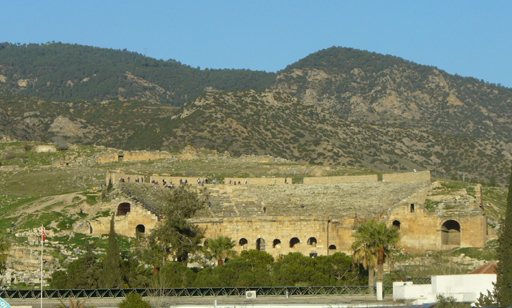 The Roman theater.
The Roman theater.
Our next stop would be Philadelphia.
